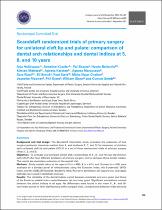| dc.description.abstract | Background and trial design: The Scandcleft intercentre study evaluates the outcomes of four surgical protocols (common method Arm A, and methods B, C, and D) for treatment of children with unilateral cleft lip and palate (UCLP) in a set of three randomized trials of primary surgery (Trials 1, 2, and 3). Objectives: To evaluate and compare dental arch relationships of 5-, 8-, and 10-year-old children with UCLP after four different protocols of primary surgery and to compare three dental indices. The results are secondary outcomes of the overall trial. Methods: Study models taken at the ages of 5 (n = 418), 8 (n = 411), and 10 years (n = 410) were analysed by a blinded panel of orthodontists using the Eurocran index, the 5-year-olds' (5YO) index, and the GOSLON Yardstick. Student's t-test, Pearson's correlation, chi-square test, and kappa statistics were used in statistical analyses. Results: The reliability of the dental indices varied between moderate and very good, and those of the Eurocran palatal index varied between fair and very good. Significant correlations existed between the dental indices at all ages. No differences were found in the mean 5-, 8-, and 10-year index scores or their distributions within surgical trials. Comparisons between trials detected significantly better mean index scores in Trial 2 Arm C (at all ages) and in Trial 1 Arm B (at 5 and 10 years of age) than in Trial 3 Arm D. The mean Eurocran dental index scores of the total material at 5, 8, and 10 years of age were 2.50, 2.60, and 2.26, and those of the 5YO index and GOSLON Yardstick were 2.77, 2.90, and 2.54, respectively. At age 10 years, 75.8% of the patients had had orthodontic treatment. Conclusions: The results of these three trials do not provide evidence that one surgical method is superior to the others. The reliabilities of the dental indices were acceptable, and significant correlations existed between the indices at all ages. The reliability of the Eurocran palatal index was questionable. Trial registration: ISRCTN29932826. | en_US |

